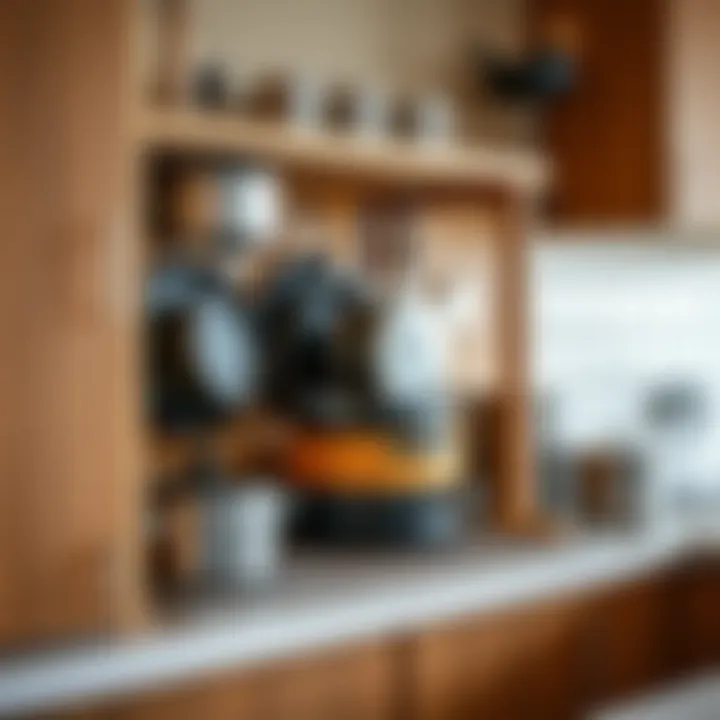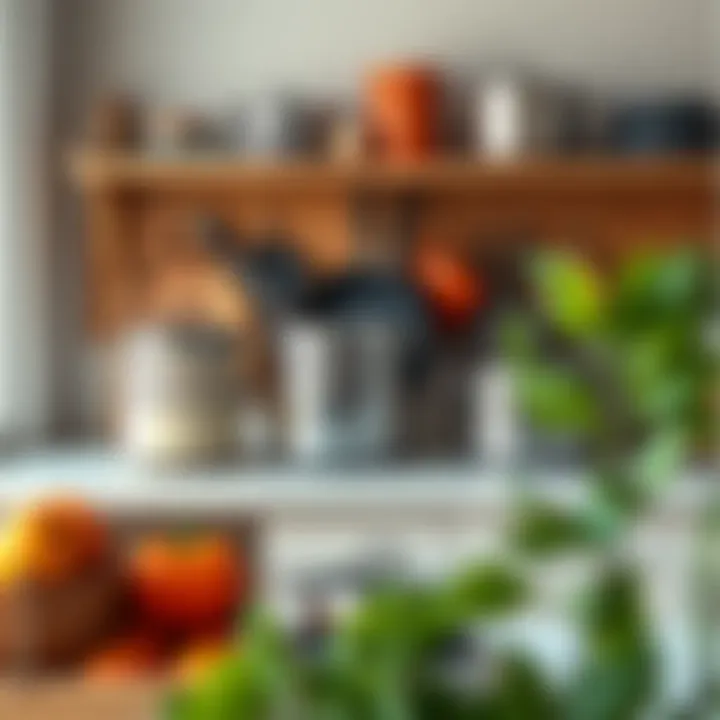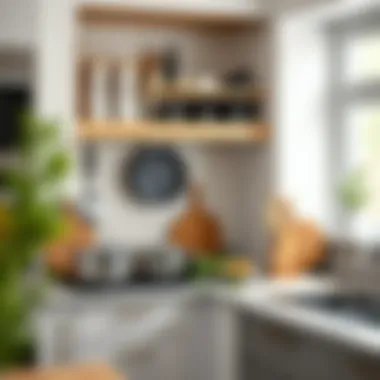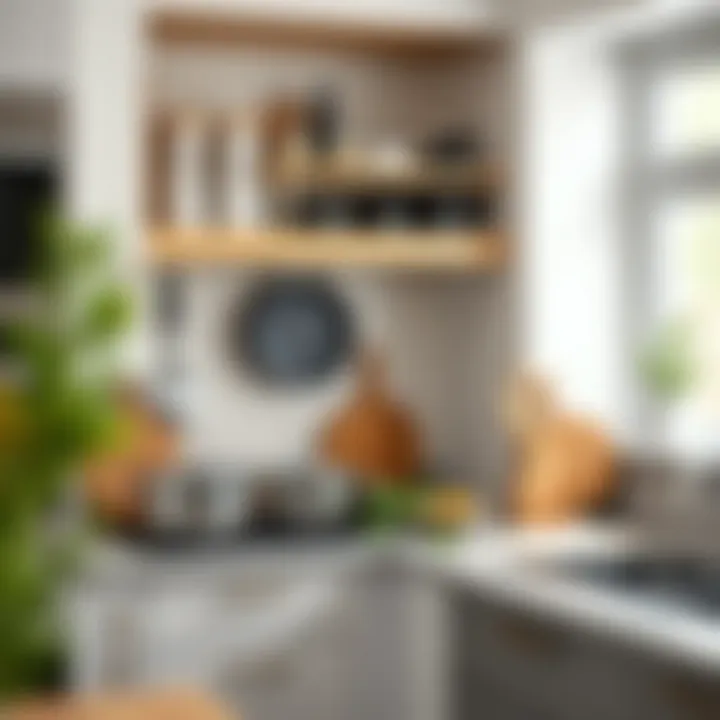Effective Strategies for Pots and Pans Storage


Intro
In the world of cooking, pots and pans take center stage. They are not just tools; they are the unsung heroes of the kitchen. But when it comes to storing them, many homeowners face a puzzle. How can you optimize your storage without sacrificing accessibility or aesthetics?
This comprehensive guide is designed to provide you with the insights and knowledge necessary to transform your kitchen storage. Whether you’re a passionate home cook or a DIY enthusiast, understanding how to manage pots and pans efficiently can elevate your cooking experience. From assessing your kitchen layout to selecting storage solutions that harmonize functionality with style, we will explore every facet of pots and pans storage so that you can make the most out of your space.
Key Points to Explore
We will delve into various storage solutions, weighing their pros and cons. The goal is not just practicality; it’s about enhancing the visual appeal of your kitchen while ensuring that you can find your favorite skillet or saucepan without turning the space into a chaotic mess.
By considering your cooking habits, lifestyle, and the layout of your kitchen, you’ll be equipped to choose the right storage types. To wrap it up, this article will distill everything into actionable insights, making it easier for you to implement what you’ve learned and take your kitchen organization to the next level.
Understanding the Importance of Kitchen Organization
In the heart of every home, the kitchen stands as a testament to functionality and creativity. It's a space where culinary magic happens, and organizing it efficiently is more than just a nicety—it's a necessity. Understanding the importance of kitchen organization enhances not only the cooking experience but also the overall flow of the household.
Effective storage solutions in the kitchen can significantly improve your cooking process. When pots and pans are stored thoughtfully, reaching for that trusty skillet or sturdy saucepan becomes effortless. Instead of rummaging through cluttered cabinets, a well-organized space allows you to find what you need swiftly, saving time and reducing frustration. Moreover, this efficiency can spark inspiration, leading to more adventurous cooking and exploration of new recipes.
The Role of Efficient Storage in Cooking
An organized kitchen is akin to a well-tuned instrument; each piece working harmoniously to achieve beautiful results. Efficient storage systems for pots and pans can streamline workflow during meal prep.
- Accessibility: Clearly organized cookware means that the tool you need is at your fingertips. No more digging through piles to find the frying pan.
- Safety: When pots are easily accessible, the chance of accidents decreases. A cluttered kitchen poses hazards, leading to potential spills and burns.
- Time Management: Knowing where everything is stored saves precious minutes when cooking. As the saying goes,
Assessing Your Storage Needs
Assessing your storage needs is a fundamental step in organizing pots and pans effectively. It’s the backbone of creating a functional kitchen space that not only accommodates your culinary tools but also promotes ease of use. Before you buy that trendy organizer or install new shelving, it’s crucial to take stock of what you’ve got. This process helps you understand what types of cookware you own, how they fit into your kitchen layout, and where the gaps in your current organization might be.
Understanding your storage needs goes beyond the basics. It’s about analyzing the varieties of pots and pans you have—be it cast iron skillets, non-stick frying pans, or heavy-duty stock pots. The uniqueness of each cookware type can influence not only how you store them but also how often you use them. By assessing these factors early on, you can ensure that your storage solutions truly reflect your cooking habits and space constraints.
Types of Pots and Pans
Cookware Materials
When we talk about cookware materials, we refer to the kinds of substances from which the pots and pans are made. Each material has its own characteristics that directly affect its performance and maintenance. For instance, stainless steel is a durable choice. It’s non-reactive, making it safe for various types of cooking. Additionally, it shines brightly, which adds to the kitchen's aesthetic appeal. On the flip side, it can be a bit heavy and may require preheating to avoid food sticking.
Another common material is non-stick, which is beloved for its ease of use and simplicity of cleaning. You can whip up that gorgeous omelet without worrying about it sticking to the pan. However, it’s essential to be cautious about using metal utensils, as they can scratch the surface.
With these considerations in mind, each cookware material may have benefits or drawbacks that impact their storage needs:
- Stainless Steel: Durable and aesthetically pleasing but heavy.
- Non-stick: Easy to clean but requires careful handling.
- Cast Iron: Excellent heat retention but needs special care to maintain.
Sizes and Shapes
The sizes and shapes of pots and pans play a significant role in determining how they can be stored. Having a range of sizes—from small saucepans to large stock pots—means your storage must be versatile. A common misstep is not evaluating whether your storage space can handle these varying sizes adequately.
For example, large, bulky pots can take up significant room, making it important to find a storage solution that maximizes vertical space or minimizes wasted areas in cabinets. Consider nested storage as one approach; smaller pots can be placed inside larger ones to save room. However, this can also pose a challenge when reaching for the specific item you need. The key is balancing accessibility and organization.
Some characteristics of pot and pan sizes include:
- Small Pots: Perfect for quick meals, can be easily stacked.
- Medium Pans: Most utilized in daily cooking but may require more attention in organizing.
- Large Cookware: Often bulky, requiring strategic placement for easy access.
Evaluating Kitchen Space
Layout Considerations
Evaluating your kitchen layout is vital. You’ve got to play the long game here—how can you make the best use of available areas without clutter? Your kitchen layout should accommodate the frequency with which you cook and the space based on your unique kitchen setup. For instance, if your stove sits far from the storage, that could lead to inconvenient trips while prepping.
Moreover, dishes that you use regularly should be within arm’s reach. Open shelves can be useful in some cases, while deep cabinets might trap your favorite frying pan deep within. Considering these layout aspects allows you to devise a system where pots and pans can seamlessly integrate into your cooking process.
Available Space
The available space is a filtered-down version of what you evaluated in terms of layout. It’s all about counting the square footage, measuring cabinet dimensions, and pinpointing exactly where you can install storage solutions. This metric directly affects your organization strategy—what you can cram into your cabinets and how to stack, hang, or otherwise organize your cookware.
Assessing available space not only encompasses physical dimensions but also considers under-utilized areas. For example, above cabinet spaces are often overlooked. Alternatively, using wall space through vertical storage solutions can significantly improve your setup. Keep in mind:
- Vertical utilization: Hanging pots or using rack systems can be a game changer in smaller kitchens.
- Depth of cabinets: Deep cabinets require different organizing strategies compared to shallower ones.
- Accessibility: Prioritize user-friendliness, ensuring that accessing your pots is straightforward.
Traditional Storage Solutions
When it comes to organizing the pots and pans in your kitchen, traditional storage solutions play an essential role. They establish a baseline for how cookware can be stored efficiently while maintaining easy access during meal preparation. Utilizing cabinets and drawers ensures that your kitchen stays neat and orderly, key factors in cooking efficiency.


Adopting traditional methods often simplifies the process of pots and pans storage without overwhelming you with the complexity of modern systems. Let’s delve into the core elements of cabinet storage and drawer organizers, starting with their pros and cons.
Cabinet Storage
Pros and Cons
Cabinet storage has been the go-to method for many home cooks and enthusiasts. One main advantage is its spaciousness; cabinets can accommodate various sizes of cookware. Storing pots and pans behind closed doors creates a seamless and uncluttered appearance in the kitchen, which can be particularly pleasing.
However, a con to consider is accessibility. If your pots are stacked deep in a cabinet, retrieving the one you need can turn into a game of Tetris. This arrangement may slow down your cooking process, which can be frustrating. Nevertheless, if you manage your cabinet space wisely, you can significantly reduce these drawbacks.
Best Practices
To get the most out of your cabinet storage, certain best practices come into play. Start by grouping similar items. For instance, place frying pans together and sauté pans beside them. This strategy allows for easier selection when you're in the midst of cooking.
Consider using adjustable shelves to create custom heights for your pots and pans. This flexibility can be a game changer. Additionally, using dividers or stackable organizers can help keep items tidy and prevent scratches or damage. This way, you'll be maximizing space effectively while also keeping your cookware in good shape.
Drawer Organizers
Types of Organizers
When optimizing storage, drawer organizers can prove to be indispensable. There are various types available, each catering to different needs. For example, adjustable dividers can be altered to fit various sizes of cookware, ensuring a fit that suits your collections.
Another type is the tiered organizer, allowing you to view and reach your pots easily without having to dig through clutter. The key characteristic of these organizers is the ability to streamline your cooking preparation, giving you quick access to the cookware you need.
However, it's crucial to note that not every drawer can accommodate large pots; they often require deeper drawers to avoid the hassle of banging and clanging.
Installation Tips
Installing drawer organizers may seem simple at first glance, but proper techniques can make all the difference. Before installation, measure your drawer's dimensions accurately. This ensures that what you choose to install fits like a glove. Use mounting hardware correctly, as misalignments can lead to frustration and wasted space.
Consider labeling each section of the organizer for added clarity. This small detail can help maintain your system over time, making it easier to find the utensil you need quickly. Remember, investing time in the right installation can lead to a more streamlined cooking environment, which aligns with your kitchen organization goals.
In summary, traditional storage methods offer practical solutions for cookware. Utilizing both cabinet and drawer storage efficiently lays the foundation for a kitchen that is both functional and aesthetically pleasing.
By focusing on these traditional aspects, you will find that both the organization of your space and your cooking experience will improve. Explore these solutions and consider how they can be tailored to fit your unique needs.
Innovative Storage Solutions
Innovative storage solutions have become essential in modern kitchens, especially for pots and pans which can take up significant space. By adopting such solutions, homeowners can not only optimize storage but also enhance the kitchen's overall efficiency. These solutions focus on utilizing often overlooked areas, incorporating smart design features, and creating systems that make pots and pans more accessible and organized.
In this section, we will discuss the role of wall-mounted racks and hanging systems, analyzing their design options and practical benefits. The emphasis will be on how these innovative solutions can transform kitchen storage – moving away from cluttered drawers and heavy cabinets to a more streamlined approach that promotes ease of access.
Wall-Mounted Racks
Design Options
When selecting wall-mounted racks, a variety of design options exist, which can make a notable difference in the aesthetic and functional appeal of your kitchen. From sleek, minimalistic designs to rustic wooden racks, the options cater to different taste preferences and kitchen themes. A key characteristic of these designs is their adaptability; they can be installed in various spaces, such as above countertops or on kitchen islands.
One popular design choice features metal racks with hooks that allow for easy hanging of pots and pans, creating a visually pleasing display while saving cabinet space. The unique feature here is the combination of functionality and decor; not only do these racks keep cookware within reach, but they also serve as an artistic element in the kitchen. However, it's important to consider that they might not suit every kitchen style.
Installation Guidelines
Proper installation is crucial for wall-mounted racks to ensure they remain sturdy and safe, particularly when holding heavy cookware. One guideline is to locate wall studs before drilling, as this provides the most secure support. A characteristic of good installation practices includes ensuring the rack is high enough to avoid head bumps yet low enough for easy access.
Another unique aspect of installation is the variety of mounting hardware available, ranging from adjustable brackets to fixed mounts. While adjustable options offer greater flexibility in height, fixed mounts may provide increased stability. However, complexities can arise if the wall structure is not straightforward, requiring additional tools and skills for a successful setup.
Hanging Systems
Types of Hanging Systems
Hanging systems come in various types, offering flexibility based on kitchen layout and personal preference. Some common types include rail systems, pegboard setups, and ceiling-mounted hooks. A key advantage of these systems is their ability to maximize vertical space, which is often wasted.
Rail systems are popular for their ease of use; they allow for adjustable hooks, enabling arrangements that can evolve with your cookware collection. In contrast, pegboards provide additional customization options, as users can rearrange hooks and accessories according to their specific needs. Each system boasts its unique features, but homeowners must consider factors such as ceiling height and hook weight limits, which may impact functionality.
Benefits
The benefits of implementing hanging systems are manifold. Firstly, they greatly improve accessibility – pans that used to be buried in cabinets can now be reached at a moment's notice. Additionally, by using vertical space effectively, hanging systems help reduce clutter and promote a cleaner kitchen appearance.
Notably, these systems also can act as decorative elements. The visibility of attractive cookware hanging in an organized manner can enhance kitchen aesthetics. On the downside, some might find the look of hanging pots to be less appealing in more formal cooking spaces. Moreover, it requires regular maintenance to avoid dust accumulation, which can be a minor drawback but easily manageable with routine cleaning.
In summary, innovative storage solutions like wall-mounted racks and hanging systems offer smart alternatives to conventional storage methods. They not only optimize space but also elevate usability and kitchen design.
Utilizing Vertical Space


In kitchens, where every nook and cranny tends to serve its purpose, utilizing vertical space becomes an art form. The ceiling often stands neglected, while walls go unadorned; this is especially true in smaller kitchens where floor space is at a premium. Employing the vertical dimensions of your kitchen not only maximizes storage potential but also enhances accessibility to your pots and pans, which is particularly crucial for any home chef. Properly arranged vertical storage makes cooking more efficient by reducing the time spent rummaging through cupboards.
Shelving Units
Open vs. Closed Shelving
Open shelving carries a charm of its own, allowing pots and pans to be in plain sight. This visibility fosters a sense of organization, as you can easily spot your cookware at a moment’s notice. However, one must consider the downside, such as dust accumulation and the potential need for more frequent cleaning. On the contrary, closed shelving keeps everything neatly tucked away, providing a cleaner look and shielding your things from the grime of a busy kitchen.
Key Characteristic: The openness of open shelving can be a beneficial choice for those who want to display their nicely arranged cookware, making each pot or pan part of the kitchen’s decor. For instance, placing colorful ceramic cookware on a well-designed shelf adds personality to the space.
Advantages/Disadvantages: Open shelving allows for easier access and can make the kitchen feel larger, while closed shelving keeps things out of sight and may protect them better. Ultimately, the choice depends on your lifestyle and cleaning habits.
Style Considerations
When it comes to style considerations, the potential to blend functionality with aesthetics is significant. Open shelving can add to the rustic charm or modern vibe of your kitchen, while closed shelving often conforms more closely to minimalist trends. Choosing materials and finishes that complement your existing decor is essential; a mismatched unit can overshadow your kitchen's design.
Unique Feature: Consider combining both types by integrating both open and closed units within the same space, which offers the opportunity to showcase your finest dishware while keeping everyday items hidden.
Advantages/Disadvantages: Balancing style with practical function is key, so think through your color palette and material choices to enhance or contrast your kitchen’s style effectively.
Overhead Storage Solutions
Ceiling Racks
Ceiling racks are the unsung heroes of vertical storage. They liberate floor space while serving as practical extensions of your kitchen's storage capabilities. A ceiling-mounted system allows pots and pans to hang within arm's reach yet out of the way, leading to a tidy appearance while retaining necessary accessibility.
Key Characteristic: The ability to customize dimensions based on your kitchen's layout makes ceiling racks a favorable choice for many. They come in various configurations, from simple bars to intricate grids, allowing for creative showcase opportunities.
Advantages/Disadvantages: Though exceptional for maximizing space, these racks can pose drawbacks if not installed securely. It’s vital to consider the weight of the items you’re hanging and ensure proper weight distribution for safety.
Mounting Techniques
Effective mounting techniques are paramount when installing overhead racks. Proper installation ensures that your pots and pans remain securely in place and can help with overall kitchen safety. The priority should be on finding suitable hardware that can stand the weight and will last through the rigors of daily kitchen use.
Key Characteristic: Creative approaches, such as using wall studs or ceiling beams for mounting, can decrease the risk of accidents and improve longevity.
Advantages/Disadvantages: On one hand, poor mounting may lead to dropped cookware, while smart techniques enhance the sturdiness of your setup. Additionally, considering the placement can make or break the flow of your kitchen—ensure your hanging cookware is accessible yet not an obstacle.
This exploration of vertical space showcases that, while not every solution will fit every kitchen, a thoughtful approach can harmonize aesthetics with functionality, leading to a well-ordered culinary space.
Specialized Storage Solutions
Specialized storage solutions play a crucial role in the effective organization of pots and pans within a kitchen. When standard cabinets and shelves don’t cut it, these tailored approaches can enhance accessibility and streamline the cooking process. They are especially beneficial for those who own a diverse array of cookware, ensuring that everything has a place and is easy to access.
The importance of specialized solutions cannot be overstated, particularly in smaller kitchens where space is a premium. Investing in the right tools not only makes cooking more efficient but also helps maintain a clutter-free environment, which is vital for both aesthetics and functionality.
Pot and Pan Organizers
Types and Features
When delving into pot and pan organizers, you'll find a variety of shapes and mechanisms. Notably, tiered racks and pull-out systems have gained popularity. These designs offer vertical storage, maximizing cabinet height and allowing for easy visibility of your cookware selection. A tiered rack, in particular, helps place larger pots at the back while keeping the more frequently used pans in front.
On the other hand, sliding or pull-out organizers can neatly tuck into kitchens’ deeper areas. This feature makes it a breeze to reach those hard-to-get pots without having to dig through a chaotic mess. Though, one might have to keep an eye on the compatibility of these systems with existing cabinets to avoid space issues.
Selecting the Right Organizer
Choosing the right type of organizer involves more than just picking a pretty design. You have to consider your cooking habits—do you tend to reach for specific pots often, or do you rotate your collection? Organizers, such as cabinets with adjustable dividers, allow for flexibility that can be tailored to whatever your cooking style demands.
Moreover, investing in organizers that make good use of vertical space can be particularly advantageous for urban dwellers where every inch counts. However, think about the installation process; some require a bit more effort and tools than others, which can influence your decision.
Pull-Out Shelves
Benefits of Pull-Out Systems
Pull-out shelves offer a seamless way to access pots and pans. These systems can dramatically improve how one utilizes their kitchen cabinetry by allowing full visibility of stored items. The standout characteristic of pull-out systems is their ability to eliminate deep, inconvenient spaces that often lead to forgotten cookware.
As they slide out, you’ll find the previously hidden pots immediately accessible. One has to consider, though, that some of these shelves can come with hefty price tags. However, they often end up being a worthwhile investment in time and ease of cooking.
Installation Considerations
When it comes to installation, pull-out shelves demand careful attention. Ideally, you want to ensure that the shelf size aligns with your cabinet dimensions before purchase. This facet is a key reason why so many might shudder at the planning stage; when not done right, it can result in a disaster, leaving you with inadequate storage.
One can engage a professional to ensure a perfect fit, which, while adding to the cost, often saves additional time and stress in the future. Remember, if you’re opting for DIY installation, measure twice and cut once—this old saying rings true when setting up pull-out shelves.


"Specialized storage not only saves space but can sometimes redefine how we interact with our kitchens."
By thoughtfully choosing these storage options, you foster an environment where creativity can flourish in the kitchen. With pots and pans neatly organized, cooking becomes considerably less of a chore and more about joy and exploration.
Prioritizing Accessibility
Enhancing accessibility in pot and pan storage is a fundamental element of any well-organized kitchen. When pots and pans are easy to reach, cooking becomes a smoother experience, saving both time and frustration. This aspect is particularly vital for individuals who frequently prepare meals or multitask in the kitchen. If your storage solutions require too much bending or digging through clutter, it diminishes the overall efficiency of meal prep.
Arranging by Frequency of Use
Organizing Strategy
Setting up an organizing strategy that prioritizes the most frequently used pots and pans can transform your cooking routine. The core idea is simple: keep what you need close at hand. Arranging your cookware in a way that reflects your cooking habits not only saves time but also maintains a sense of order. For instance, if you use your skillet more often than a dutch oven, position the skillet in an easily accessible space, such as the front of a shelf or in a dedicated drawer.
This strategy is beneficial because it reduces the hassle during busy cooking sessions, allowing for a more efficient workflow with minimal movement across the kitchen.
Space-Saving Techniques
Incorporating space-saving techniques is another clever way to enhance accessibility. Utilizing vertical space by stacking pots and pans or using specialized organizers can declutter your kitchen. This can be particularly advantageous for smaller kitchens where every inch counts. For example, consider sliding racks or tiered organizers that enable you to see all your cookware at a glance.
This not only makes it easier to find what you need but also enhances the visual appeal of your kitchen, as pots and pans are neatly arranged rather than piled high.
While such systems can work wonders, it’s important to ensure that the heavier pans are placed on lower levels to avoid strain when retrieving them.
Color Coding and Labeling
Benefits of Organization Systems
Implementing a color coding and labeling system adds an extra layer of accessibility to your pots and pans storage. Not only does it allow for quick identification of different cookware types, but it also contributes to a visually harmonious space. For instance, you could use different colors for different materials such as stainless steel, non-stick, or cast iron. This approach quickly guides you to the right cookware throughout your cooking process.
Moreover, such organized systems help to eliminate confusion during meal prep, especially when sharing kitchen duties with family members or guests.
Implementation Tips
To effectively implement a color coding and labeling system, begin by categorizing your pots and pans based on type or use frequency. Use durable labels that can withstand moisture and heat, ensuring longevity in a kitchen environment. For example, clear adhesive labels can be attached to the handles of pots or pans. Another technique could involve using colored dots or tape on shelves to correspond with the labeled cookware.
While this method is advantageous for quick recognition, it may take a little time to get used to initially, particularly for those not familiar with the color scheme. Starting with just a few colors can simplify the process and gradually increase to incorporate additional categories as needed.
"A well-structured kitchen is like a well-conducted symphony, where every note is in its place, making for a harmonious cooking experience.”
Maintaining Order
Maintaining order in your kitchen is not just about aesthetics; it plays a crucial role in the overall functionality of your cooking space. When pots and pans are stored efficiently, it saves time, minimizes stress, and enhances the cooking experience. A cluttered space can lead to frustration, which in turn affects creativity in the kitchen. Having the right systems in place helps ensure that every piece of cookware is easily accessible and neatly arranged. This not only keeps the kitchen eye-pleasing but also creates an environment that fosters efficient cooking workflows.
Regular Cleaning and Evaluation
Regular cleaning and evaluation of your pots and pans storage system are vital steps in maintaining order. Over time, even the best-laid plans can become chaotic, with dust accumulating and items being shoved to the back of cabinets, out of sight and out of mind. Cleaning helps clear away the clutter that time can accumulate and gives you a chance to re-evaluate your current organization methods.
- Set a Schedule: It’s advisable to commit to a cleaning schedule. For instance, every six months, take some time to go through your cookware.
- Evaluate Functionality: While cleaning, check if your current arrangements make sense. Are your go-to pots hidden behind less useful ones? If so, rearranging them can make cooking much simpler.
"An organized kitchen is a happy kitchen—one where creativity can flourish and meals are made with joy."
Adapting to New Cookware
As culinary habits evolve or as you acquire new cookware, adapting your storage methods becomes necessary. When you invest in new pots and pans, it's essential to have a strategy to make space and reorganize accordingly. This is not just about making room; it’s about optimizing your kitchen for every piece you own.
Transitioning Strategies
Transitioning your storage systems calls for a thoughtful approach. As you integrate new items into your collection, consider what you can repurpose or donate. A strategy that often proves beneficial is prioritizing frequency of use. Items that you reach for daily should take precedence in visibility and accessibility. On the flip side, seasonal or infrequently used pots can be stored further out of reach. Keeping a flexible mindset is key here; think of your storage as a living system that needs to grow with you.
- Benefits of Transitioning: One key characteristic that makes this approach advantageous is its adaptability. It allows your storage to evolve alongside your cooking style.
- Unique Features: New cookware often comes with its own set of requirements—be it larger dimensions or specific storage needs. Recognizing these features can help tailor your storage solutions effectively.
Timing and Methodology
Timing your organization efforts around key moments—like spring cleaning or post-holiday evaluations—ensures that you consistently keep your kitchen in check. Also, the methodology of your approach impacts efficiency. For instance, you might opt for a bulk reorganization where you adjust everything at once or take gradual steps, changing one section at a time.
- Popular Timing Choices: Many people find the start of each season as a natural cue to reassess kitchen order. This habit creates a rhythm that prevents long-term clutter build-up while keeping your cooking space fresh.
- Advantages of Methodological Organization: Having a systematic approach means you’re not left scrambling in moments of chaos. Instead, you can capitalize on every new arrival, ensuring it fits seamlessly into your existing setup.
Navigating storage options, especially as new pieces come into play, is ultimately about establishing a rhythm that suits your unique kitchen needs. Maintaining order is essential not only for practical reasons but also to encourage pleasure in the cooking process.
The End: Tailoring Storage to Your Lifestyle
Incorporating the right storage solutions for pots and pans can significantly impact the flow and efficiency of any kitchen. As you consider your options, it’s crucial to align your storage choices with your unique cooking habits and space constraints. No two kitchens are identical; therefore, developing a tailored approach allows for maximizing functionality and aesthetic appeal. This final section encapsulates this idea, showing how a personalized system contributes not only to a well-organized kitchen but also to a more enjoyable cooking experience.
Making Informed Choices
When it comes to organizing pots and pans, informed decision-making is key. Start by evaluating your cooking style. Do you often whip up large meals for family gatherings, or do you mostly prepare quick weeknight dinners? This insight should guide your storage setup.
A few things to consider:
- Material Matters: Opt for storage solutions that accommodate the various materials of your cookware. For instance, heavy cast iron might need sturdy shelves, while lighter pots could fit nicely in drawers.
- Frequency of Use: Place the cookware you use most often within easy reach. For example, if you’re always reaching for that beloved sauté pan, it should be close at hand rather than tucked away in the back of a cabinet.
- Vertical versus Horizontal Storage: Determine which layout fits your kitchen best, considering the height of your ceilings. Wall-mounted racks or hanging systems might make use of vertical space if floor area is limited.
These thoughtful choices can transform your kitchen into an efficient workspace, allowing you to focus more on creating delicious meals rather than searching for your pans.
Long-Term Maintenance and Improvement
Maintaining an organized kitchen is not a one-time affair; it requires ongoing attention and adjustments over time. Regular evaluation of your storage setup can help keep things running smoothly.
- Assess Regularly: Set aside time every six months to review your organization strategy. Are there pots and pans that you no longer use? Cyclical evaluations can prevent clutter from creeping back in.
- Stay Flexible: Your cooking habits may change—perhaps you’ve started experimenting with new cuisines that require different tools. Be willing to adapt your storage to incorporate new pieces as they become essential in your kitchen.
- Invest in Quality: Over time, upgrading your storage solutions can enhance the space’s functionality. High-quality organizers last longer and can often better accommodate a variety of cookware shapes and sizes.















